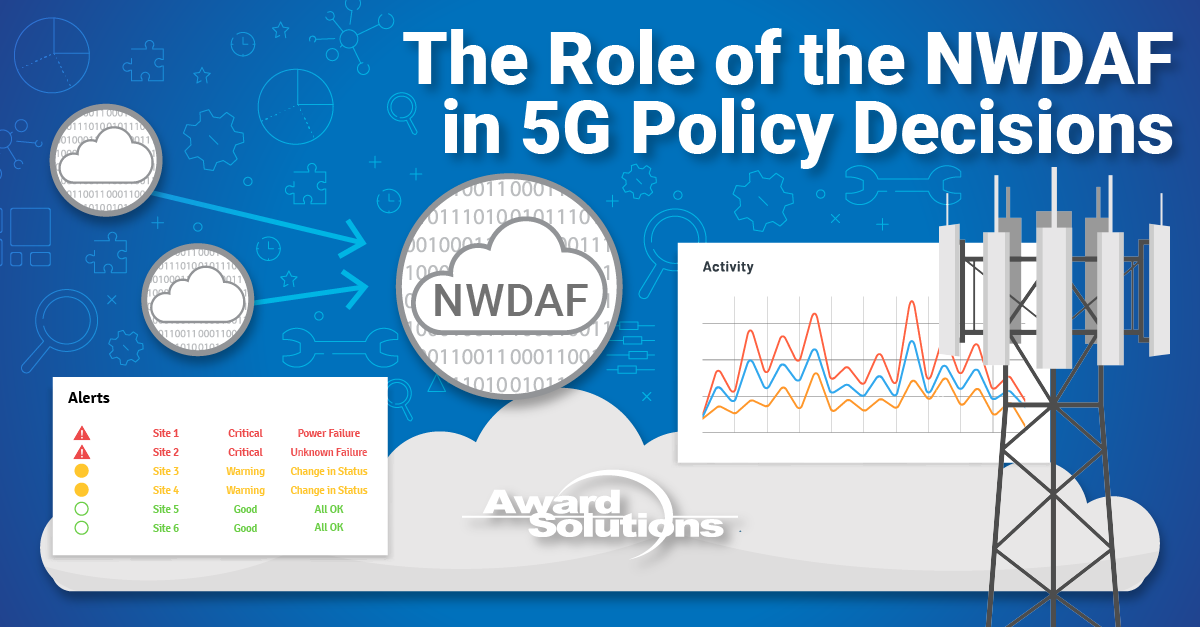
The Network Data Analytics Function (NWDAF) provides descriptive statistics and predictive analytics in a 5G system. It also collects data from various network functions (ex: AMF, SMF, PCF) and Operation, Administration, and Maintenance (OA&M) functions, and the collected data is fed into a machine learning algorithm. Ultimately, NWDAF provides analytics results to various consumers in the 5G network. One of the important analytics consumers is the Policy Control Function (PCF) which defines access and mobility, session management, charging, and UE policies.
What Analytics can the PCF learn from NWDAF?
Utilizing the Service Based Architecture (SBA) in 5G, the PCF can subscribe to several analytics that can affect the policy of how services are offered. Examples of analytics collected by the PCF are:
1. Network slice load level
a. Network slice resource utilization across the network
b. The number of predicted UE registrations and PDU sessions for a slice
2. Service experience, which provides the Mean Opinion Score (MOS)
a. For a network slice UE(s)
b. For an application(s) used by UE(s)
c. For an edge application(s) used by UE(s)
d. For an application(s) used by UE(s) over certain radio access technology or frequency
3. Network performance
a. Average gNB(s) ratio used in the analytics generation
b. Average and peak gNBs resource utilization
4. Data or transaction dispersion - data volume dispersion (i.e., distribution or pattern) for a certain location
5. WLAN performance - the number of UEs for a certain Service Set Identifier (SSID)
6. UE-related analytics
a. Abnormal UE behavior - detecting malicious apps running on a UE
b. UE mobility - predicting the location of UE(s)
c. UE communication - predicting the start and stop of communication and traffic volume
d. User data congestion - predicting the application throughput for UE(s)
All the analytics that NWDAF provides can be statistics that describe what has transpired in the past or future predictions. To assist the network functions such as the PCF, the NWDAF provides some qualifications for its predictions, such as spatial, time period, and confidence levels, as appropriate.
What May Trigger the PCF to Subscribe for Analytics
Imagine that you are a parent with a great understanding of your kid. An appropriate reaction to your kid's accomplishment should be encouraging, much like a 5G network that makes its customers happy by adapting to needs (ex: Quality of Experience) since it understands the service requirements, network activities, predictions, and network load.
Utilizing the Service Based Architecture (SBA) in 5G, the PCF can subscribe to analytics with NWDAF. Other players, such as an Application Function (AF), might cause the PCF to trigger an analytics subscription. Such triggers by the PCF can be operator defined. In addition, the PCF may start subscriptions based on events due to regular system operation.
Policy Actions by the PCF due to Analytics
The PCF may update policy decisions in response to certain analytics based on operator-defined policies. Here are some examples of PCF policy decisions based on received analytics:
a. Service experience - Update the 5QI to provide a better overall quality of service for a certain application or flow
b. Network performance - Update the Background Data Transfer (BDT) policy
c. UE mobility - Update the service area where UE mobility is allowed
d. Unexpected UE location - Update the service area where a UE is allowed to be on the move.
In some instances, the operator can define a policy decision at the PCF by a combined set of analytics. For example, a PCF's reception of a specific analytics ID (ex: user data congestion) might trigger the PCF to obtain additional analytics, such as data dispersion for UE(s), before making policy decisions.
The PCF is a crucial component that controls several aspects of the 5G wireless network policies, such as QoS, charging, traffic gating, and more. While the PCF can obtain most of the NWDAF analytics, policy update decisions are primarily defined according to the operator's policy, which creates added challenges for operators to make proper policy decisions according to their network dynamics and demands. However, most likely, we can expect vendors to compete in defining certain policy decisions without the operator's intervention while allowing the operator to make changes and updates.
Ultimately, the 5G network shall benefit from the analytics obtained by the PCF to enhance the service offering and increase the QoE of its customers.
